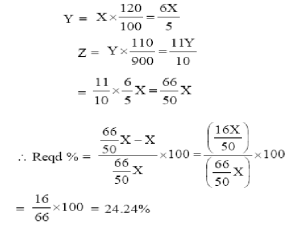1.The circumferences of two circles are 264 metres and 352 metres respectively. What is the difference between the area of the larger circle and that of the smaller circle?
1) 3412m² 2) 4132m² 3) 4312m² 4) 5312m² 5) 5043m²
Click here to see Answer
ANS:3
2πR=352==>R=56
2πr=264==>r=42
πR²-πr²==> 22/7(56² -42²)=4312
2. A 380-metre-long train running at a speed of 80 kmph will take how much time to cross another 420-metre long train running in opposite direction at a speed of 48 kmph?
1) 20.12 seconds 2) 22.5 seconds 3) 20.5 seconds 4) 18.57 seconds 5) 19.68 seconds
Click here to see Answer
ANS:2
380+420/80+48 = 25/4 Kmph
25/4 * 18/5 = 22.5
3. A number X is increased by 20% to get another number Y. A third number Z is obtained by increasing Y by 10%. By what per cent should Z be decreased to get X?
1) 26.51% 2) 24.24% 3) 28.36% 4) 31.71% 5) 34.98%
Click here to see Answer
ANS:2

4. A can do a piece of work in 42 days. B can do the same piece of work in 36 days. C can do it in 56 days. A worked for 18 days and handed it to B, who worked for 9 days and left the job for C. How many days will C take to finish the work?
1) 16 days 2) 20 days 3) 24 days 4) 22 days 5) 18 days
Click here to see Answer
ANS:5
A’s wrk in 18days=1/56 *18=3/7
B’swork in 9days=1/36*9=1/4
total wrk they(A+B) did=3/7 +1/4=19/28
remaining wrk done by C in = 9/28 *56/1= 18days
5. A boy walks 14 metres to cross a square field diagonally. What is the area of the square?
1) 78 sq mtrs 2) 120 sq mtrs 3) 118 sq mtrs 4) Cannot be determined 5) None of these
Click here to see Answer
ANS:5
Area of square= 14²/2=196/2=98
Q.(6 – 10): A bag contains 4 red, 5 brown and 6 white balls. Three balls are drawn randomly
6.What is the probability that balls drawn contains exactly two red balls ?
1) 54/145 2) 66/455 3) 46/105 4) 31/455 5) None of these
Click here to see Answer
ANS:2
n(S) = 15C3 = (15 * 14 * 13)/6 = 455
2 red balls can be selected in 4C2 = 6 ways
And remaining one ball can be selected in 11C1 = 11 ways
P(E) = (6*11)/455 = 66/455
7.What is the probability that the balls drawn contains no brown ball ?
I) 11/65 2) 31/91 3) 24/91 4) 31/455 5) None of these
Click here to see Answer
ANS:3
n(S) = 15C3 = 455
Three balls have to be selected from 4 red and 6 white balls
No. of ways = 10C3 = 120
P(E) = 120/455 = 24/91
8. What is the probability that the balls drawn are not of the same colour ?
1) 34/455 2) 31/105 3) 74/105 4) 421/455 5) None of these
Click here to see Answer
ANS:4
n(S) = 15C3 =455
If all three balls are of same colour, then no. of ways = 4C3 + 5C3 + 6C3 = 4 + 10 + 20 = 34
P(E) = 34/455
For being different colours P(E) = 1 – 34/455 = 421/455
9. If two balls are drawn randomly then what is the probability that both the balls are of same colour ?
1) 31/105 2) 74/105 3) 34/455 4) 421/455 5) None of these
Click here to see Answer
ANS:1
n(S) = 15C2 = 105
n(E) = 4C2 + 5C2C + 6C2 = 6 + 10 + 15 = 31
P(E) = 31/105
10.What is the probability that the three balls drawn are of different colour ?
1) 21/91 2) 31/105 3) 24/105 4) 24/91 5) None of these
Click here to see Answer
ANS:4
n(S) = 15C3 = 455
n(E) = 4C1 + 5C1 + 6C1 = 4 * 5 * 6 = 120
P(E) = 120/455 = 24/91
Thank You 🙂 🙂 🙂

















